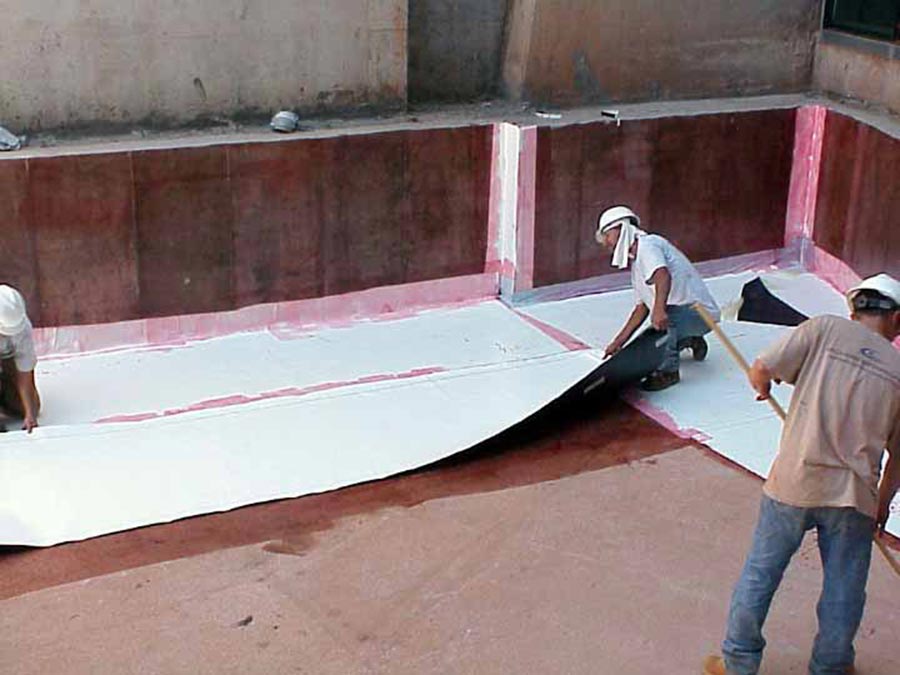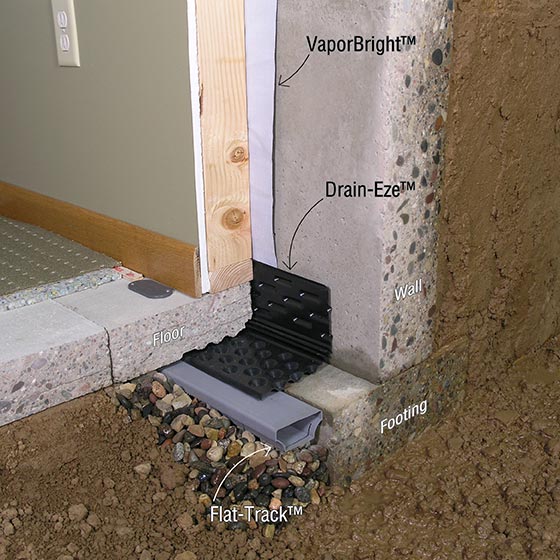what to put down on a concrete floor as a water bearer
Concrete slabs are not impervious to h2o. In fact, given the correct environmental weather, the flooring slab can transmit gallons of water into the living space as vapor, and in farthermost cases, really evidence ponding water.
"High wet levels can contribute to unhealthy air, mold, and even structural bug," says Ken Huggins, president of Basement Rescue. "Fifty-fifty if you're non living there and it's just storage, that moisture tin ruin floors, rugs, wooden flooring and the items being stored. At that place are as well health issues and odors to deal with."
So, how does one set up a flooring with a vapor transmission problem? The pre-construction solution is to use an underslab vapor bulwark. (See The Underslab Solution in the Winter 2009 outcome online). These heavy plastic sheets effectively prevent moisture and other gasses from penetrating the slab.
Unfortunately, residential and older commercial buildings normally practise not have an underslab barrier. Or the barrier could be then torn and damaged that information technology is no longer effective. The good news is that innovative retrofit solutions exist which don't crave removing the slab.
Pinpointing the Source
The first step to determine if an underslab wet barrier is needed is to verify that wet is really coming through the slab.
Ken Cotten, possessor of Waterproof.com, says up to 90% of the moisture problems he deals with are wall-related. "Floor wet is a rarity," he says, "simply it does happen."
Joe Boccia, owner of Boccia, Inc., reports that in New England information technology's much more than mutual. Up to 50% of his calls crave some sort of floor handling.
A few years ago, Köster, a worldwide leader in waterproofing solutions, conducted a survey to pinpoint basement moisture sources. They found that 82% of cases had moisture only on the walls. A scant 4% had moisture on the floor only. The remaining xiii% had problems with both the walls and the flooring. Of the cases with moisture issues on the floor, about half had moisture seeping through cracks; the others had moisture in larger areas.
Be sure to eliminate the possibility that the moisture is coming from interior sources. Huggins says that he'due south seen basements with obviously damp floors, simply the slab was impervious. The problem was literally in the air.
"Just like a cold drinkable will grade h2o droplets on the outside of the drinking glass," he says, "if you have a common cold concrete floor and it's a really boiling climate, yous'll get a considerable amount condensation on the floors and walls."
Besides slabs, Boccia says that common sources of humidity are unvented showers, asunder dryer vents, and open windows.
Is a Barrier Needed?
The best way to decide if a wet barrier is needed is to tape a canvass of plastic (roofing at to the lowest degree several square feet) to the flooring. Subsequently 24 hours or more, skin back the plastic and come across if there are signs of condensation. Water on the lesser of the sheet means moisture is coming through the slab. If droplets form on the top of the plastic canvas, the problem is probable acquired past excessive indoor humidity.
Be aware that moisture problems are frequently seasonal, and that a single "dry" result doesn't rule out problems. Test over again subsequently rainstorms, spring thaws, or other event that creates soil saturation most your abode.
In that location are other tell-tale signs of flooring moisture. If the surface is painted or sealed, there might be h2o-filled blisters in the blanket. Pop them, and they sometimes squirt h2o several anxiety into the air.
Exposed concrete sometimes shows efflorescence, a residue—usually white—of mineral salts being left behind past the migrating wet.
Dehumidification
If tests determine that the wet is condensation-related, a dehumidifier is often all that is needed. HQ Hometek and EZ Breathe—as well as several others—make units specifically for basement dehumidification.
Exist aware that this approach requires a "breathable" flooring system. There are porous carpets, paints, and other floor coverings on the market that permit wet to pass through them. Otherwise, wet will build upwards between the slab and the finish floor arrangement.
Huggins tells of one task where the floor of an unfinished basement was literally soaking. He discovered that all of the water was condensation. "Nosotros put in a dehumidifier, and two days later the trouble was gone," he says. "Merely you've got to keep the machines running," he continues. "If they get out on vacation and shut everything off for a few weeks, when they come dorsum there'll exist water on the floor again."
Erica LaCroix, at EZ Exhale, says water vapor coming through slabs accounts for up to 80% of a home's indoor wet. Basement humidifiers capture that moisture at it source, the ground level, keeping airborne moisture levels at acceptable levels.
"Dehumidifiers will but remove humidity from the air," warns Boccia. "If you have an actual seep, it won't exercise anything with liquid water."
Sealants, Coatings, and Densifiers,
Some companies market sealers and coatings for the residential market place—typically epoxy or urethanes—to seal off the slab. In order for these products to bond properly, the floor must be clean, dry, and gratis of impurities. Often, shot-diggings is used to prepare the surface.
This type of production is typically used in conjunction with footing drains. Otherwise the pressure level is also extreme.
Boccia points out coating strengths don't matter if the concrete is weak. "The coating may be tested to 25,000 psi," he says, "but the tensile strength of the concrete is just ii,500 or 3000 psi, and so the concrete volition spall and the coating will neglect."
Huggins adds, "If the flooring shifts, at that place'due south nothing strong enough to hold two slabs of concrete together. Then if the floor cracks, your barrier will fail.
Bryan Coulter, vice president of architectural products at Polyguard, says information technology'south a matter of using the correct product for the circumstances.
On residential jobs though, the stakes are college. "Once the coating is covered, it can't be checked," says Tom Fallon, vice-president of sales and marketing at Cosella-Doerken. 'It's basically 'seal it off and hope it works.' But y'all become enough hydrostatic pressure or vapor force per unit area under it and it will inevitably flake off."
Ane class of "blanket" that may work on residential jobs is the crystalline slurry coats. Made past companies such equally Aquafin, Köster, Kryton, Xypex, and others, the chemicals soak into the concrete and course crystals inside the voids and channels inside the surface of the concrete. This reduces permeability and porosity of the physical, restricting the flow of fluids—but not vapors—through the matrix. Because they bond with the concrete chemically, they cannot delaminate. Depending on the job, product chosen, and installation technique, these may exist a viable selection.
Split Slabs
In commercial applications, the "split slab" is a common solution. Basically, the crew lays a regular underslab membrane over the existing flooring, and then pours another concrete floor on top of it.
Split-slabs are sometimes used in new construction, in loftier-utilize areas where designers want to separate the "wear deck" of the concrete from the "structural deck." These include parking garages, airport roadways, and sports facilities. As such, they have a long and successful history. Water that passes through the vesture deck at cracks and common cold joints is caught by the cached waterproofing membrane where it tin be managed to drains.

For commercial applications, a divide-slab may be the all-time solution. Tom Stoebner, business organization development manager at Raven Industries, says there are literally dozens of companies making good quality membranes for this type of work, including his own.
"The products that work well for divide slabs are the aforementioned ones that work well in traditional underslab applications," he says. "As long as the product meets ASTM 745, it's probably more than adequate."
For residential applications though, carve up slabs have drawbacks. For starters, in that location'southward the event of interfering walls and the hassle of getting concrete into the basement. Simply there'southward as well the outcome of headspace.
"ACI doesn't recommend that slabs exist less than 3 inches thick, to ensure even curing and drying," explains Fallon, "so that ways that yous'll lose about four inches of headroom."
The Dimple Membrane
A better way, says Fallon, is to utilize a dimple membrane. "You lot simply lay the dimpled sheet down, and and so put down the OSB or plywood subfloor over that," he explains. "You'll lose one inch of headroom instead of iii or four. Any moisture that comes up from the bottom condenses on the waterproof dimple sheet and runs freely to the existing sewer bleed. The occupants won't even meet information technology."
He points out that dimple sheets also create a thermal suspension, and creates a more than comfy flooring. Most importantly, it's reliable. "It takes away the 'if factor,'" he says.
Boccia says he sometimes uses dimple sheets, but instead of topping them with forest, pours three inches of concrete over the height. He admits that this is a "belt-and-suspenders" approach and goes far beyond what'south commonly necessary.
Ground Drains
Drainage is an integral part of whatsoever waterproofing solution. Except for the dimple membrane solution above, which uses the pre-existing floor drain, all of the methods discussed in this article should be coupled with perimeter footing drains.
"Perforated pipe in gravel is the most common solution to flooring moisture problems," says Boccia. "It deals with the water no matter where information technology'south coming from, and removes water from under the slab before it ever comes into contact with the concrete."
Cotten, at Waterproof.com, markets at to the lowest degree four different types of perimeter drains. "What we practise is remove a narrow strip of the slab— virtually half dozen inches wide—around the interior of the basement. We exit the footings in place. Nosotros remove merely enough to catch the h2o coming under the footer."

"These salvage a tremendous amount of pressure level," Cotten continues. "Sometimes when we puncture the slab, h2o literally comes spraying out." Installers and so place an inconspicuous drain channel in the trench to touch on a permanent solution.
Joe Boccia, who has been installing perimeter drains for more than 35 years, stands by the perimeter drain approach. His visitor offers a fully-transferrable guarantee that the problem will non render for the life of the structure.
Conclusion
Whether the number of slab-related wet problems is 50% of your calls, or but 10%, in that location are a number of solid, proven solutions. Whether the situation requires installing perimeter drains, a split slab, dimple membrane, dehumidifiers, or some combination, a wide range of products are available to meet your need. north
Source: https://www.waterproofmag.com/2011/06/underslab-retrofits-sealing-slabs/
0 Response to "what to put down on a concrete floor as a water bearer"
Post a Comment